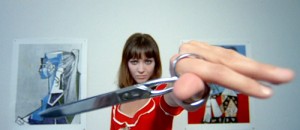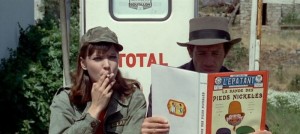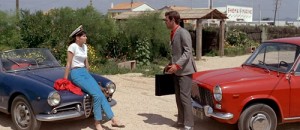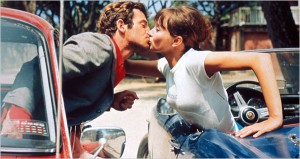

“I wanted to tell the story of the last romantic couple,” Jean-Luc Godard said of this brilliant, all-over-the-place adventure and meditation about two lovers on the run (Jean-Paul Belmondo and Anna Karina). Made in 1965, this film, with its ravishing colors and beautiful ‘Scope camerawork by Raoul Coutard, still looks as iconoclastic and fresh as it did when it belatedly opened in the U.S. Godard’s misogynistic view of women as the ultimate betrayers is integral to the romanticism in much of his 60s work — and perhaps never more so than here — but Karina’s charisma makes this pretty easy to ignore most of the time. The movie’s frequent shifts in style, emotion, and narrative are both challenging and intoxicating: American director Samuel Fuller turns up at a party scene to offer his definition of cinema, Karina performs two memorable songs in musical-comedy fashion, Belmondo’s character quotes copiously from his reading, and a fair number of red and blue cars are stolen and destroyed. In French with subtitles. 110 min. (JR)

 Read more
Read more
It’s really sad: Wikipedia had listings for no less than eight different men named John Berry when I originally posted this article, but the film director (1917-1999) wasn’t one of them (fortunately, this is no longer the case); and you won’t find an article about him in Senses of Cinema’s Great Directors, either. I can’t say I knew the man well. but I consider myself fortunate to have spent some time with him in a variety of places — including film festivals in Rotterdam and Vienna, in Paris, and even one enjoyable evening at a jazz disco in Taipei. His accounts of his experiences with Orson Welles in the Mercury Theater -– which included several hours of holding up scenery during the shooting of Too Much Johnson — were priceless.
The following comes from the February 2, 2001 issue of the Chicago Reader. — J.R.
 Boesman & Lena ***
Boesman & Lena ***
Directed by John Berry.
Written by Athol Fugard and Berry.
With Danny Glover, Angela Bassett, and Willie Jonah.

Director John Berry got his big start as an actor in Orson Welles’s Mercury Theatre in 1937. Welles then introduced him to film in 1938 when he hired him as assistant director on a silent slapstick film made to accompany and introduce portions of the stage farce Too Much Johnson. Read more






